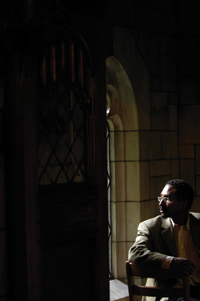|
||
      |
New deal has old roots
Sociologist Omar McRoberts traces presidential overtures toward black churches

Long before George W. Bush’s faith-based initiatives, McRoberts
says, Franklin D. Roosevelt recruited black preachers to help spread
the New Deal’s social gospel.
When sociologist Omar McRoberts, AB’94, caught a video glimpse of President George W. Bush opening the Office of Faith-Based and Community Initiatives in 2001, he was struck by the supernumeraries. Flanking Bush were several African American clergy. “I’d never heard of most of them,” recalls McRoberts, whose expertise in race and religion would have led him to expect otherwise. But although the faces were unfamiliar, he recognized the tactics.
Presidents have been elevating politically sympathetic clergy to positions of visibility and authority since the days of Franklin D. Roosevelt, says McRoberts, an associate professor of sociology who also teaches in the Divinity School. Roosevelt perfected the strategy to muster support among Northern urban African Americans for his New Deal policies (and 1936 reelection). Effective and nearly identical, the sermons delivered by pro-administration ministers helped redirect black churches’ religious thought and institutional form. Yet the phenomenon remains largely unexamined, says McRoberts, who earned a Harvard PhD in 2000: “Social scientists have had a lot to say about the impact of religious institutions on the development of social policy and politics, but very little has been said about how the state has managed to alter the religious landscape through policy development.”
On the heels of finishing his first book, Streets of Glory (University of Chicago Press, 2003), which examined black storefront churches in Boston, McRoberts decided to document black religious responses to social-welfare policies. Arguing that those policies changed black churches’ understanding of “what it means to impact the world in a righteous way,” he plans to publish a book in the next two years.
In papers and documents at the National Archives in Washington and Roosevelt’s presidential library in Hyde Park, New York, McRoberts uncovered “lively examples” of plans to woo black congregations. Internal notes; strategic discussions recorded in memos, briefs, and position papers; and newspaper clippings saved by staffers “tell us a lot,” he says, about the Roosevelt administration’s thinking. “African American churches are central. The documents show how aware Roosevelt is of the connection between black notions of progress, liberation, and political behavior.”
African Americans’ historic loyalty to Abraham Lincoln’s Republican Party, however, posed a problem for the Democratic Party and Roosevelt. At that time “liberation tendencies in black churches” viewed African Americans as “an exiled people comparable to the biblical Hebrews, being led out of captivity by a God who loves justice but whose key political prophets are identified with the Republican Party,” McRoberts says. How to loosen those loyalties?
One attempt, which McRoberts found in a 1936 New York Age newspaper clipping, was an illustration titled The Three Emancipators, a direct parallel to the Bible’s three emancipators from Egypt. First appearing on a huge painting famously unfurled at a 1936 Democratic pre-election rally in Madison Square Garden—organized by the Good Neighbor League, a group targeting the African American and labor vote—the image portrayed three figures: Jesus Christ as liberator from sin, Abraham Lincoln as liberator from bondage, and FDR as liberator from social injustice. “It reveals how [political organizers] are thinking about religious symbols,” McRoberts says, “working with them, actively inserting them into black religious settings.”
Tapping like-minded church leaders and clergy to spread a new social gospel, Roosevelt and the Democratic Party elevated them to prominence. Their message, reflecting New Deal policies, shifted focus away from individual sin and salvation to social salvation, emphasizing that social injustice constitutes an important topic for Christian thought. “There were always exponents of social gospel”—a movement seeking to bring society into alignment with Christian principles—“in black churches,” McRoberts says, “but they didn’t begin to enjoy normative space until the time of the New Deal.”
Other policies inadvertently changed the institutional organization of black churches. When Roosevelt established his alphabet soup of executive agencies, new budgets “created a new target for religious action.” As a result, in the mid-1930s black churches joined to form the first national, black, ecumenical organization—the Fraternal Council of Negro Churches—“to interact with the federal government around issues of race.” In fact, McRoberts believes the religious foundation of the civil-rights movement grew out of the ideological platform Roosevelt established. “The civil-rights movement took the social-gospel message for granted—fight social sin through mass movement.”
Now McRoberts—who is studying four denominations: the African Methodist Episcopal Church, the National Baptist Convention, the Church of God in Christ, and the Nation of Islam—sees a retreat from the focus on social injustice. “Republican-leaning African American clergy are lifted to positions of visibility they haven’t enjoyed for a very long time,” he says. Their message stresses “individual moral values instead of structural inequalities,” holding individuals responsible for their own problems rather than blaming the system. In January 2005 a group of Bush-supporting black clergy formed the High Impact Leadership Coalition, a conservative-leaning Christian organization “devoted to that agenda.”
With his New Deal research all but complete, Mc-Roberts now turns to other church-changing political eras: Lyndon Johnson’s Great Society and War on Poverty (when focus shifted from national to local, federally fund-----ed social-service efforts) and contem-porary welfare reform, from its roots in the Reagan administration through George W. Bush’s faith-based initiatives. He’ll continue to “record the ongoing debate as it unfolds. The challenge,” he admits, “will be knowing when to stop.”